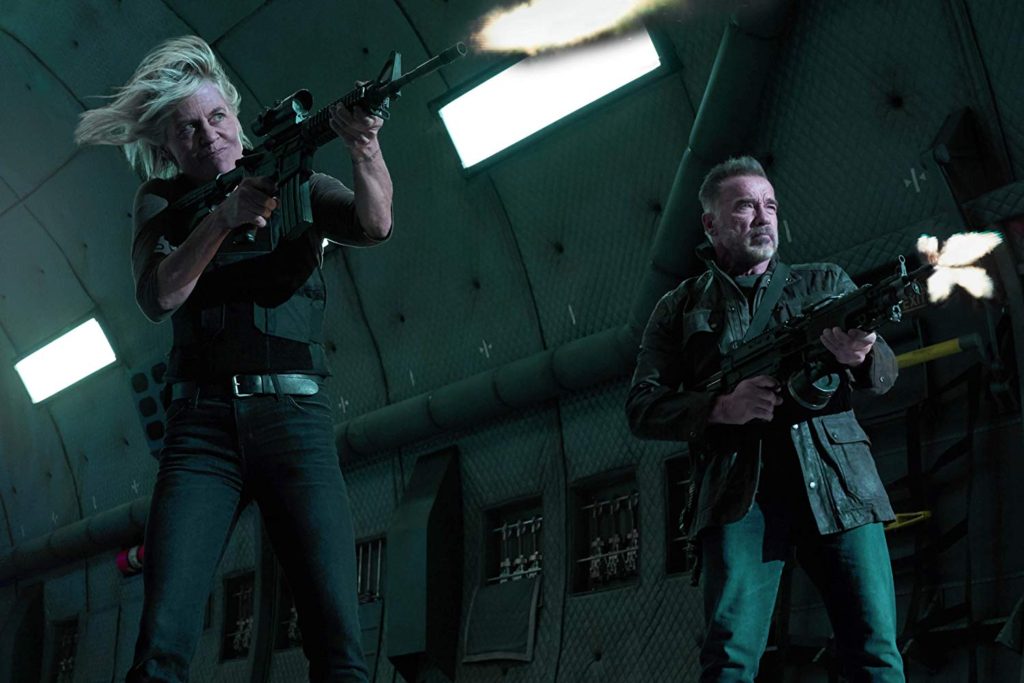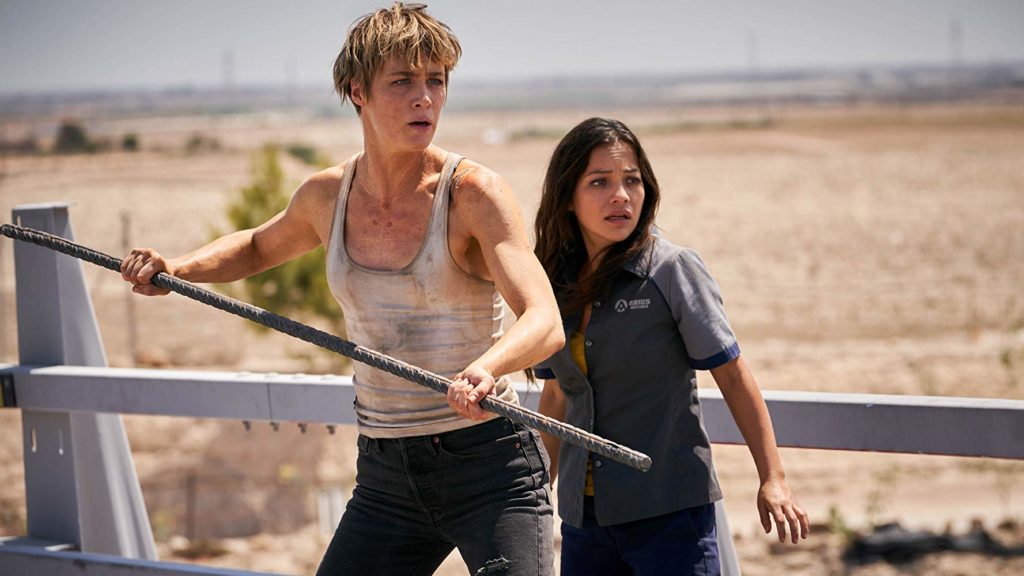“Terminator: Dark Fate,” playing with the franchise’s past and future, and with a more morose tone than previous iterations, is a fine movie that blends what made parts 1 and 2 so successful with a theme that could have launched the movie as a standalone with almost the same effect. Almost. While “Dark Fate” brings back “Terminator” writer James Cameron and re-unites him with Linda Hamilton and Arnold Schwarzenegger, what works about the film is that it creates a world of its own – a seemingly darker fate for its characters to fall victim to, and plants these iconic characters into a world they both understand and don’t. The film also creates a world – and characters – that lends to easy likability, is fleshed out well, and manages to do something “Terminator 3,” “Terminator: Salvation,” and “Terminator: Genisys” failed to accomplish: it makes us care about its characters again.
What you need to know about this movie is that it’s not about John Conner, not about Skynet, and not about the world that filled every other movie past “Terminator 2: Judgement Day” with a rehashing of a tired plot that played on the original’s story and legend. “Dark Fate” reimagines the idea of the Terminator by placing him in the employ of not Skynet, but yet another computerized artificial intelligence who is attempting to wipe out a soon-to-be rogue warrior in a not so distant future where mankind is replaced by robots. If this sounds familiar, it is, but, with slow character building and the courage to branch out on its own, “Dark Fate” inadvertently creates a picture with a unique tone and an immediacy that feels authentic.
The film centers around a girl from Mexico City named Dani (Natalia Reyes) who is targeted by a terminator (a relentless Gabriel Luna) for unknown reasons. There’s much new here, such as a picturesque look at Mexico City and the peaceful life of its denizens, as well as an audience that knows what terminators are but – thanks to Sarah Conner’s brave exploits from the first two films – characters that do not. There’s of course some backstory about what happened to Skynet and the Conners after their last exploit, as well as what launched this new AI, but it’s better left unmentioned. Because “Dark Fate’s” aggressor feels both familiar and unknown, he packs a more dangerous feel and a more ominous implication as we are left to wonder exactly how desperate the future that birthed him really is.
“Dark Fate” has to bite off a lot to accomplish its goals, and, somehow, the ultimate union of Daniella to a new protector named Grace (Mackenzie Davis), a hardened Sarah Conner (Linda Hamilton), and a rogue, decommissioned terminator named ‘Carl’ (Arnold Schawzenegger) seems fluid and not as messy as it could have been. Of course, the script by Cameron and four other writers is robust, and is required to pull off a desperate balancing act. As such, there are quite a few missteps, plot holes, and suspensions of disbelief that one must go through to enjoy the picture. But it’s an easy ask. “Dark Fate” renewed my faith in a franchise I thought had nothing left to give.

This film is more complicated yet simpler, and, rather than focus on a thousand and one plot twists, centers on this new group’s fight for survival against a seemingly unstoppable terminator. As such, the film boasts many impressive battles, such as a factory fight that leads to a car chase in Mexico City that shows the extreme prowess of both the Terminator and Grace, who has been physically augmented by a future that needs her to protect Dani at all costs. The CGI is equally impressive. The treatment the FX team gives a young Sarah Conner and terminator at the film’s opening is a work of wonder, as are effects given to a new terminator that can split in two and fight as both man and machine. The cinematography by Ken Seng is big and bold, and the reimagined score, originally written by Brad Fiedel, is used to give the picture authentic and captivating emotions.
The acting this time around is engaging and competent, while changing some things up a bit. Grace, very much like Kyle Reese from the first film, appears out of place and in over her head, but, since being augmented, is very much in control of protecting Dani. Davis is a powerful female lead; and, alongside a repurposed Linda Hamilton, the two make an authentic duo. The script gives Hamilton’s Sarah Conner a new mission: having spent decades hunting rogue terminators in a revenge quest, she sees something in Dani that she needs to protect. Hamilton is both badass and funny – some of her one liners are the funniest in the film, though some late emasculation of Arnold’s T-800 provides comic fodder that prods along the film’s second act. The film also plays with the idea of a conscience, with the T-800, raw machine, unwavering in his protection of his new family, unable to be bartered with by Luna’s attempts at machine-to-machine reason in one of the film’s stronger scenes. As Dani, Reyes performs adequately, but is lost amidst a film designed for powerhouses. During the early film, she’s painted helpless and young, and transitions believably to a woman capable of standing on her own later on. Dani is a nice person, and we care about her, which is, ultimately, what makes the fight to save her work.
At the end of the day, what works about “Dark Fate” is it somehow takes a recycled concept and makes it fresh again. The acting, action, and story all borrow from older “Terminator” films but aligns them in a way that feels new; the emotion is authentic, and you can tell that Cameron, with nods to our current political climate, strong female leads, and mankind’s predilection towards endless war, wants to evolve his film for the times. The film’s ending battle is powerful, taut, and emotional. Any “Terminator” film will endlessly be compared to the perfect “Judgement Day.” Is “Dark Fate” on par with that film? It’s likely an impossible question to answer. But one critic reviews it’s the “third best ‘Terminator’ film, which is more a compliment than it sounds.” It’s hard to disagree.


